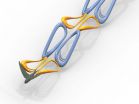The data from Genesis, which collected material from the solar wind blowing from the sun, reveal differences between the sun and planets with regard to oxygen and nitrogen, two of the most abundant elements in our solar system, the researchers report in two studies in the June 24 issue of the journal Science. And although the differences are slight, the research could help determine how our solar system evolved.
"We want to understand how rocky planets form, particularly our rocky planet," said Genesis co-investigator and UCLA professor of Earth and space sciences Kevin McKeegan, who was the lead author of the Science study on oxygen. "To understand that, we need to understand how the isotope composition of the most abundant element in the Earth came to be what it is."
On Earth, the air contains three kinds, or isotopes, of oxygen atoms, which differ in the number of neutrons they contain. All three have eight protons, and almost all have eight neutrons (O-16), but a small proportion of isotopes contain nine neutrons (O-17) or 10 neutrons (O-18). Although isotopes of an element behave similarly, there are subtle differences in reaction rates according to the isotopic mass, McKeegan said.
"We found that the Earth and moon, as well as Martian and other meteorites, which are samples of asteroids, have a lower concentration of the O-16 than does the sun," McKeegan said. "The implication is that we did not form out of the same solar nebula materials that created the sun. Just how and why remains to be discovered."
McKeegan and his colleagues measured, for the first time, the isotopic composition of oxygen in the solar wind. They found that the sun has about 6 percent more O-16 — relative to both of the minor oxygen isotopes — than the Earth does. Because the sun represents the "starting composition of the entire solar system," these findings are surprising, McKeegan said.
"It's the most abundant element in the Earth, and it is isotopically anomalous," he said, adding that something chemically unusual happened to the material that eventually formed the Earth and other rocky planets some 4.6 billion years ago, after the sun had already formed.
"The present composition of the rocky planets is quite different from the starting composition in a way we do not fully understand," he said, "but it must have involved interesting chemistry before the planets formed in the gaseous nebula that produced the sun and planets."
The data were obtained from an analysis of material ejected from the outer portion of the sun. That material can be thought of as a "fossil of our nebula" because scientific evidence suggests that the sun's outer layer has not changed measurably in billions of years. The sample of solar material collected by Genesis was small, but there was enough to be analyzed using UCLA's MegaSIMS (secondary ion mass spectrometer).
"This is the first time the heavy elements in the sun have had their isotope composition determined with precision, directly from solar material," McKeegan said. "The Genesis mission was a success. The mission has achieved its highest priority objectives. We are learning how planets form."
Analyses of meteorites from Mars indicate that oxygen on Mars is very similar to oxygen on Earth, but not identical, McKeegan said.
Genesis launched in August 2001. The spacecraft traveled to the L1 Lagrange Point, about 1 million miles from the Earth, where it remained for 886 days between 2001 and 2004, passively collecting solar wind samples.
On Sept. 8, 2004, the spacecraft released a sample return capsule that entered the Earth's atmosphere. Although the capsule made a hard landing — the result of a failed parachute — in the Utah Test and Training Range in Dugway, Utah, it marked NASA's first sample return since the final Apollo lunar mission in 1972 and the first material collected beyond the moon.
Co-authors of the oxygen study included Veronika Heber, a UCLA research scientist in the Department of Earth and Space Sciences; George Jarzebinski, senior electronics engineer at UCLA; Chris Coath, a former UCLA researcher who designed the ion optics of the MegaSIMS; Peter Mao, a former UCLA researcher who is currently an astrophysicist at the California Institute of Technology; Antti Kallio, a former UCLA postdoctoral scholar who acquired much of the solar wind data; Takaya Kunihiro, a former UCLA postdoctoral scholar currently at Japan's Okayama University; and Don Burnett, a professor at the California Institute of Technology, who was Genesis' principal investigator. A team from Los Alamos National Laboratory led by Roger Wiens built a device on the Genesis spacecraft for the analysis of oxygen and nitrogen from the solar wind. Wiens and his colleagues are also co-authors of the study. NASA funded the research.
"The sun houses more than 99 percent of the material currently in our solar system, so it's a good idea to get to know it better," Burnett said.
A second paper in Science by different researchers details differences between the sun and planets with regard to the element nitrogen. Like oxygen, nitrogen has one isotope (N-14) that makes up nearly 100 percent of the nitrogen atoms in the solar system, but there is also a tiny amount of N-15.
Researchers studying the same Genesis samples found that compared to the Earth's atmosphere, nitrogen in the sun and Jupiter had slightly more N-14 — but 40 percent less N-15. The sun and Jupiter appear to have the same nitrogen composition, but as with oxygen, the nitrogen composition of the Earth and the rest of the inner solar system is very different.
"These findings show that all solar system objects, including the terrestrial planets, meteorites and comets, are anomalous compared to the initial composition of the nebula from which the solar system formed," said Bernard Marty, a Genesis co-investigator from the Centre de Recherches Pétrographiques et Géochimiques in France and lead author of the second Science study. "Understanding the cause of such a heterogeneity will impact our view on the formation of the solar system."
The Jet Propulsion Laboratory in Pasadena, Calif., managed the Genesis mission for NASA's Science Mission Directorate in Washington, D.C. Genesis was part of the Discovery Program managed at NASA's Marshall Space Flight Center in Huntsville, Ala. Lockheed Martin Space Systems in Denver developed and operated the spacecraft. Analysis at the Centre de Recherches Pétrographiques et Géochimiques was supported by the Centre National d'Etudes Spatiales and the Centre National de la Recherche Scientifique, both in Paris.
INFORMATION:
For more information on the Genesis mission, visit http://genesismission.jpl.nasa.gov.
UCLA is California's largest university, with an enrollment of more than 38,000 undergraduate and graduate students. The UCLA College of Letters and Science and the university's 11 professional schools feature renowned faculty and offer 328 degree programs and majors. UCLA is a national and international leader in the breadth and quality of its academic, research, health care, cultural, continuing education and athletic programs. Six alumni and five faculty have been awarded the Nobel Prize.
For more news, visit the UCLA Newsroom and UCLA News|Week and follow us on Twitter.
END


